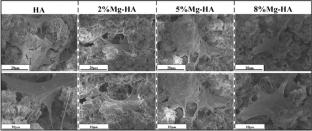Fabrication and Characterization of Magnesium-Doped Hydroxyapatite Coatings via Solution Precursor Plasma Spraying
Abstract
Ion doping of hydroxyapatite (HA) has been increasing in popularity as a chemical approach to endow it with new properties. In this work, the solution precursor plasma spraying (SPPS) technique was used to prepare the magnesium (Mg)-doped HA coating on the titanium substrate. SPPS is a relatively new one-step deposition technique that allows ion doping and coating deposition to occur synchronously, saving time and costs. The XRD and FT-IR analysis confirm that Mg ions were incorporated into the HA structure and the main phase of the coatings belongs to the HA phase. The results demonstrate the feasibility of using the SPPS technique to prepare the doped HA coating. The addition of Mg ions causes lattice distortion of HA, which leads to a reduction in the chemical and thermal stability of the HA coating. The dissolution behavior of the coatings was investigated by immersing them in phosphate-buffered saline solution for different durations. The Mg-doped HA coating shows relatively higher solubility than the undoped HA coating. With the increase of Mg doping amount, more Ca2+ and Mg2+ are released from the coating samples. The adhesion strength of the coating is measured by scratch tests. The 5% Mg doped-HA coating shows the strongest bonding to the substrate. An improvement of 19.6 N is achieved compared to the undoped HA coating. The biocompatibility and bioactivity of the coating samples were evaluated based on the behavior of osteoblasts (MC3T3-E1) in vitro. Cell staining and MTT assay show better cell attachment and proliferation ability on the Mg-doped HA coatings. The presence of Mg in the coating also stimulates the expression of alkaline phosphatase (ALP) and the formation of mineralized nodules in MC3T3-E1 cells. Therefore, the Mg-doped HA coatings prepared by SPPS can be used as a promising implant coating material for orthopedic applications.


 求助内容:
求助内容: 应助结果提醒方式:
应助结果提醒方式:


